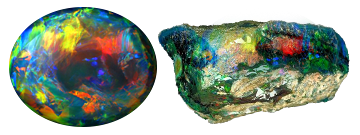 Photo of Opal in Processed & Rough Form
Photo of Opal in Processed & Rough Form
Opal is a mineral with a hardness of 6 out of 10 on the Mohs scale of mineral hardness [?]. These Amorphously structured gems are made of hydrated silica gel, their full chemical compound being SiO2,nH2O.
Opal is hydrated silicon dioxide. It has the same chemical composition as quartz but contains about one-tenth (and sometimes as much as one-third) water.
It is never crystalline, but it displays a rich play of colors, or "fire" caused by the internal refraction of light by the array of tiny spheres of amorphous silica which for a compact, three-dimensional network in the mineral. It may be somewhat porous, in which case it is dangerous to immerse it in liquids other than water.
It may have a whitish to light gray, pale green, sky blue, smoke gray black, yellowish to orange, or reddish background color.
It can be semi-opaque, with a vaguely porcelainlike appearance, or similar to broken glass, with shiny shell-like fracture.
It is more often translucent and milky, with an appearance that is so characteristic, it is described as "opalescent."
It occurs as narrow veins of up to 10cm or more, or as nodules, inside cavities or cracks in silica-rich rocks. It may also be found pseudomorphous after other minerals.
Opal is normally found in association with effusive magmatic rocks, such as rhyolites, andesites, and trachytes, having been deposited in cracks and cavities by aqueous fluids at low temperature. In Australia, it is found both in connection with trachytes and basalts, and in siliceous sandstone where hydrous silica has been precipitated, perhaps through alteration of feldspars by percolating waters, in an environment subjected to very long periods of stable water conditions.
The most highly-prized varieties display internal iridescence due to light diffraction by its network of tiny spheres. These types are collectively known as noble opal or precious opal. The range of colors apparently depends on the size of the spheres, or even the distance between the rows of spheres.
White precious opal is the variety which has been known and used for the longest time, and was, up to the end of the nineteenth century, the noble opal 'par excellence,' praised by Pliny the Elder as the ultimate in gemstones, due to its marvellous and mysterious, iridescent qualities. It is white like watered-down milk ground color, whose patches will be violet to blue for structures with very small spheres, gradually turning to green, yellow, orange, and red as the size of the spheres increases.
Black precious opal is a variety known and appreciated only since the beginning of the twentieth century, after the discovery of Australian deposits. Before that, it was only found occasionally, as a true rarity, and was regarded with some mistrust because in some cases it was known to be obtained by artifical coloration. Genuine black precious opal has a bluish gray, smoke gray to black color. The range of colors and shapes of the patches are roughly the same as for white opal.
Apart from precious opal, there is another type of opal known as common opal. It is usually fairly translucent, cloudy, and without opal's characteristic iridescence, due to the fact that the spheres of silica composing it are too large. It is generally of a dull and pale color, but it has a well-appreciated and best-known variety known as Fire opal, which is brightly-colored, yellow to orange, or brilliant scarlet.
The specific gravity [?] for Opal is 2.1, its refractive index [?] is 1.37-1.47, and its double refraction [?] is None.
History
The name Opal is derived from Greek "opallios," from the Sanskrit "upala" meaning "precious stone."
One area of eastern Czechoslovakia formerly belonging to Hungary has been mining opal since Roman times and was the only source of noble opal for Europeans until the nineteenth century. Nowadays most opal comes from Australia, where the finest quality opals are found. Other sources are Mexico, and to a lesser extent, Guatemala and Honduras. Low-value or subgem quality varieties of opal are found in many other places, especially the USA (xyloid opal or petrified wood) and Iceland (where it is deposited by hot springs).
Industrial Usages
In gem quality precious opal, three sets of distinctions are made. The first, according to the ground color of the material, distinguishes light or white opal from black or dark opal. The second, applied to each of these two varieties, is based on the range of colors in the iridescent patches; and the third is based on the size, shape, and distribution of the patches. The transparent or semitransparent, non-iridescent variety, known as common opal, is also used as a gem if it is attractively-colored. Because of its orange-yellow to reddish orange color, it is known as fire opal.
White precious opal is cut into fairly convex cabochons. It is sometimes cut flat, but there is a risk of breakage, as the stone is brittle. The most valuable cabochons are the strongly curved, oval ones. The best quality gems fetch very high prices, exceeded only by the four principal gemstones (diamond, emerald, ruby, and sapphire), imperial jade, alexandrite, and black opal.
White opal has been manufactured synthetically by a French company, with iridescent patches fairly distinctive, but it can nonetheless be distinguished by an expert.
Black precious opal is also cut cabochon, and thicker gems are preferred. Those of regular outline, better suited to jewelry, are the most highly-prized. Care needs to be exercised to ensure that what may appear to be black opal is not really a thin layer of white opal on a piece of dark-colored rock.
The value of genuine black precious opal is very high, the highest for opal, and immediately after the principal gemstones. Black opal is harder to imitate than white opal.









